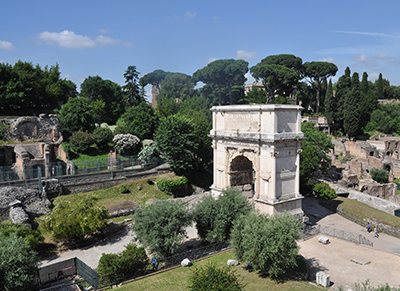How did Rome look in ancient times?
Usually when we envision ancient Rome, we imagine a world of gleaming white marble edifices and statues. This, however, is not an accurate picture. Although many Roman—and Greek—statues and monuments now appear white (or grey), they were originally brightly colored. The whiteness we see today is the result of years of weathering.
One of the most famous monuments in ancient Rome is the Arch of Titus, constructed by Roman emperor Domitian around 81 C.E. after the death of his brother and predecessor, emperor Titus. The arch celebrates Titus’s military victories during the First Jewish-Roman War (66–74 C.E.)—when the Romans infamously burned the Temple in Jerusalem. One of the arch’s panels depicts Roman soldiers carrying captured treasures from Jerusalem’s Temple, including a large menorah, through the streets of Rome.

The arch’s menorah panel. How did the Arch of Titus in ancient Rome look? The Arch of Titus Project has shown that the arch’s menorah panel was once brightly colored, but over time its colors faded, and today it appears colorless. Photo: Courtesy of Steven Fine, the Arch of Titus Project.
Today the Arch of Titus appears colorless, but how did this monument look in ancient Rome?
Using technology, an international team of scholars has digitally restored a panel from the Arch of Titus to its original color—offering us a glimpse of what ancient Rome looked like. Steven Fine of Yeshiva University, Peter J. Schertz of the Virginia Museum of Fine Arts and Donald H. Sanders of the Institute for the Visualization of History detail their restoration efforts in the article “True Colors: Digital Reconstruction Restores Original Brilliance to the Arch of Titus,” published in the May/June 2017 issue of Biblical Archaeology Review.

The team focused on the menorah panel. After creating a 3D scan of this panel, they could see the scene in more detail than ever before, which enabled them to digitally restore portions of it—even reconstructing the table of showbread and some of the Roman victors’ heads that had been lost long ago. Next the team scanned the panel for signs of color. Traces of yellow pigment were discovered on the menorah, which confirmed that the menorah had originally been painted yellow. These results aligned with the Jewish historian Josephus’s account of the Roman victory parade, wherein he describes the menorah as being gold.

This uncolored rendering of the 3D scan of the Arch of Titus’s menorah panel was created by UNOCAL, a scanning firm in Milan. Photo: Courtesy of Steven Fine, the Arch of Titus Project.
The team then added color to the rest of the panel—bringing the ancient scene to life. They colored the background sky blue, the tunics off-white, the overgarments reddish-purple, the wreaths green, the laurel berries purple, the sacred vessels gold, the trumpets silver, and the leather and wood brown. They colored the arch (in the far right of the panel) white, black and gold. Further, they added labels to the three signs held by the Roman victors; these labels were based loosely on Josephus’s text.

This digital reconstruction shows the Arch of Titus’s menorah panel after it has been restored and colored by the Arch of Titus Project and the Institute for the Visualization of History. This offers us a glimpse of what ancient Rome looked like. Photo: © 2017 Institute for the Visualization of History, Inc.
To confirm that their reconstructions are correct, the team hopes to return to the Arch of Titus soon to scan the rest of the menorah panel for color. Learn more about this project in “True Colors: Digital Reconstruction Restores Original Brilliance to the Arch of Titus” by Steven Fine, Peter J. Schertz and Donald H. Sanders in the May/June 2017 issue of Biblical Archaeology Review.
Subscribers: Read the full article “True Colors: Digital Reconstruction Restores Original Brilliance to the Arch of Titus” by Steven Fine, Peter J. Schertz and Donald H. Sanders in the May/June 2017 issue of Biblical Archaeology Review.Not a BAS Library or All-Access Member yet? Join today.
Related reading in Bible History Daily:
This Bible History Daily feature was originally published on April 24, 2017.
The post The Arch of Titus’s Menorah Panel in Color appeared first on Biblical Archaeology Society.



0 Commentaires